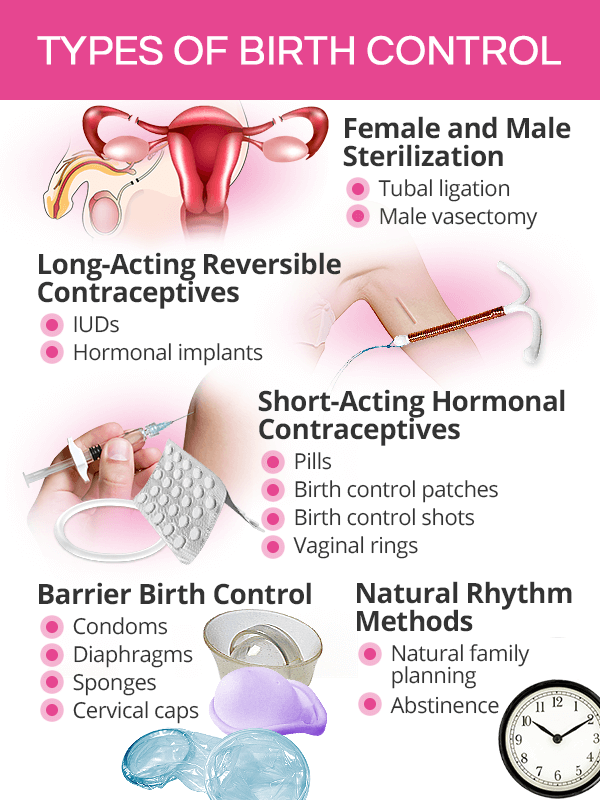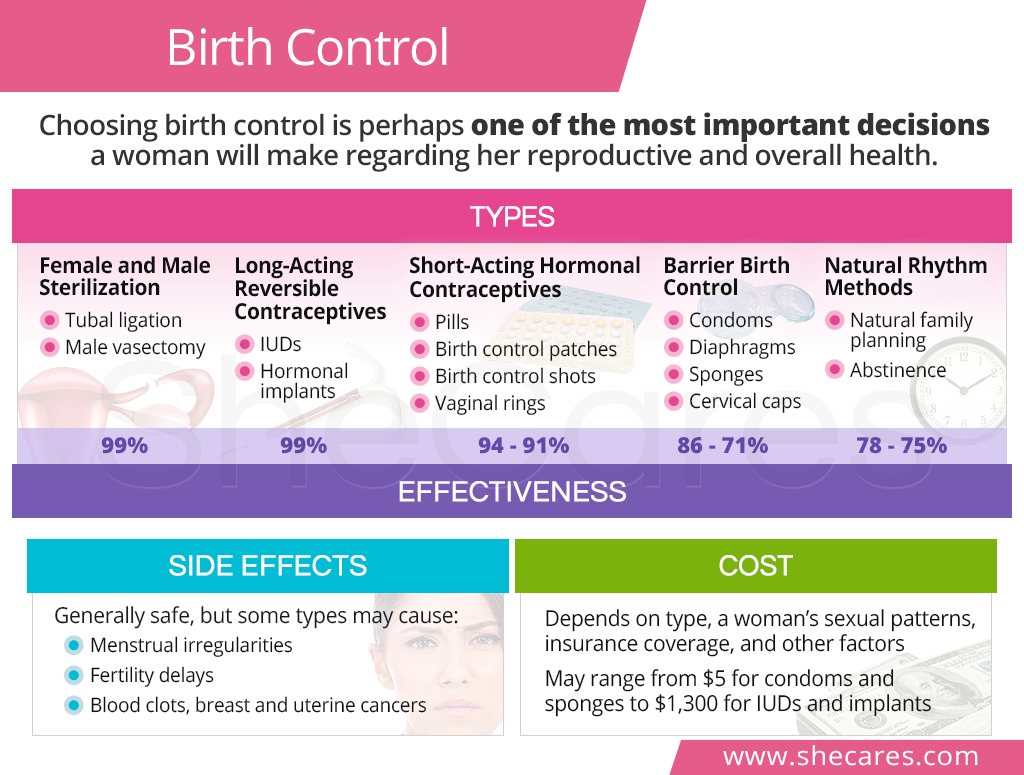Types of Birth Control

There are five general types of birth control from which a woman can choose, depending on her health status, sexual partners, and whether she plans to have children at all, soon, or in the future.
Female and Male Sterilization
These types of birth control, such as tubal ligation and male vasectomy, offer permanent protection from pregnancy. They involve making surgical changes in the reproductive organs, generally done on an outpatient basis.
Long-Acting Reversible Contraceptives
Consisting of intrauterine devices (IUDs) and hormonal implants, these types of convenient and effective contraceptive methods provide protection from pregnancy over an extended period of time (three to 10 years, depending on the type).
Short-Acting Hormonal Contraceptives
These birth control methods must be taken on a daily, weekly, or monthly basis. They include pills (containing progestin or progestin with estrogen), birth control patches, birth control shots, and vaginal rings.
Barrier Birth Control
These contraceptive options include condoms, diaphragms, sponges, and cervical caps. In order to be effective, they have to be inserted in the vagina or put on a penis each time a couple has sexual intercourse.
Natural Rhythm Methods
These birth control methods do not involve the use of any devices or medications. They consist of various methods of natural family planning, such as fertility awareness methods (FAMS) or the pull-out method. They may also involve abstinence.
Birth Control Effectiveness

When it comes to birth control effectiveness, there are two terms that are key to understand: perfect use and typical use.
Perfect use of a birth control method is when it is used correctly every single time. Typical use, on the other hand, refers to how most people use a given birth control method, taking into account errors, such as forgetting a dose.
The following are birth control methods' effectiveness rates, ranging from the most to the least effective:1,2,3
- Female sterilization methods are permanent contraceptive methods with more than 99% effectiveness.
- Long-acting birth control methods are some of the most effective (more than 99%), reversible options.
- Short-acting birth control methods' effectiveness ranges between 91 and 94%, depending on the type.
- Barrier birth control methods vary in their effectiveness from 71 to 86% with typical use.
- Natural family planning are the least effective options with 75 to 78% effectiveness.
Birth Control Side Effects
Birth control is generally safe and does not cause serious side effects. However, some types may lead to the following abnormalities that need to be considered:
Menstrual Irregularities
Changes in the menstrual cycle are some of the most common side effects of birth control. Depending on their type, women may experience scanty periods with progestin-containing IUD, heavy periods with copper-containing IUD, or absent periods with the implants, among other period irregularities.4,5
Fertility Delays
The effects of various contraceptive methods on a woman's fertility and ability to conceive heavily depend on the type she uses. Short-term delays - ranging from one up to six months - are common with birth control pills and vaginal rings.6 However, it may take up to 10 months for a woman's cycles and fertility to return after stopping birth control shots.7
Hormonal Risks
Hormonal contraception, particularly one containing estrogen, has been associated with certain health risks, including blood clots with the pills or breast cancer in women younger than 35 with the shots.8,9 Estrogen-containing birth control is also not recommended for women with a history of breast or uterine cancers.
Birth Control Cost
The financial aspect of birth control depends on several factors, including a woman's budget, reproductive needs, and her insurance coverage.
Low Up-Front Cost
Birth control types such as condoms or sponges can be purchased for a few dollars without a doctor's prescription. However, it is worth keeping in mind that the total monthly costs can quickly escalate, depending on a woman's patterns and needs.
The pills are also considered affordable. Yet since they require a prescription, there might be additional fees for doctor's visits.
Medium Up-Front Cost
The out-of-pocket cost for patches is about $150 per month; $200 monthly for the rings; $150 every three months for the shots; and up to $275 every year or two for cervical caps and diaphragms.10,11,12 There might be extra fees for doctor's visits.
High Up-Front Cost
Birth control methods like IUD and implants come with high up-front costs of about $1,300 per insertion.13,14 However, since they have to be inserted every several years, they offer long-term savings.
Contraceptive methods that require more elaborate surgical intervention, such as tubal ligation and male vasectomy, are the most expensive options up front. However, being permanent, they require just a one-time expense.
Key Takeaways
Having solid knowledge of reliable and safe birth control is a must for all women of reproductive ages. Luckily, there are five general types of attractive and convenient types of birth control, varying in a number of factors, such as the length of protection they offer and frequency of use. They also vary in how effective they are, with sterilization methods and long-acting contraceptive methods being the most effective options and barrier types and natural family planning showing to be the least effective methods. While birth control is generally safe, some types may cause menstrual irregularities, fertility delays, and other hormonal risks. Another varying factor is the cost, which may range from low up-front cost options – like condoms – to more expensive methods, like IUDs. With such a rich arsenal of reliable alternatives, virtually all women can find the type that satisfies their reproductive and overall needs.
Sources
- CDC. (2020). Contraception. Retrieved December 7, 2020 from https://www.cdc.gov/reproductivehealth/contraception/index.htm
- Contraception and Reproduction. (n.d.). Contraceptive Benefits and Risks. Retrieved December 7, 2020 from https://www.ncbi.nlm.nih.gov/books/NBK235069/
- Eunice Kennedy Shriver National Institute of Child Health and Human Development. (2017). Contraception and Birth Control. Retrieved December 7, 2020 from https://www.nichd.nih.gov/health/topics/contraception
- FDA. (2020). Birth Control. Retrieved December 7, 2020 from https://www.fda.gov/consumers/free-publications-women/birth-control
- Health Direct. (2019). Contraception options. Retrieved December 7, 2020 from https://www.healthdirect.gov.au/contraception-options
- Medline Plus. (n.d.). Birth Control. Retrieved December 7, 2020 from https://medlineplus.gov/birthcontrol.html
- Office on Women's Health. (2017). Birth control methods. Retrieved December 7, 2020 from https://www.womenshealth.gov/a-z-topics/birth-control-methods
Footnotes:
- Planned Parenthood. (n.d.). Birth Control. Retrieved December 12, 2020 from https://www.plannedparenthood.org/learn/birth-control
- NHS. (2020). How effective is contraception at preventing pregnancy? Retrieved December 12, 2020 from https://www.nhs.uk/conditions/contraception/how-effective-contraception/
- Kinds Health. (2016). Birth Control Methods: How Well Do They Work? Retrieved December 12, 2020 from https://kidshealth.org/en/teens/bc-chart.html
- Contraception. (2018). Contraceptive method use in the United States: trends and characteristics between 2008, 2012 and 2014. Retrieved July 13, 2020 from https://www.ncbi.nlm.nih.gov/pmc/articles/PMC5959010/)
- Planned Parenthood. (n.d.). Birth Control Implants. Retrieved July 13, 2020 from https://www.plannedparenthood.org/learn/birth-control/birth-control-implant-nexplanon/what-are-the-disadvantages-of-birth-control-implant
- MedlinePlus. (2020). Birth control pills. Retrieved December 7, 2020 from https://medlineplus.gov/ency/article/007460.htm
- Kid's Health. (2018). The Birth Control Shot. Retrieved December 7, 2020 from https://kidshealth.org/en/parents/bc-shot.html
- CDC. (2020). Contraception. Retrieved December 7, 2020 from https://www.cdc.gov/reproductivehealth/contraception/index.htm)
- Family Doctor. (2020). Depo-Provera: An Injectable Contraceptive. Retrieved December 7, 2020 from https://familydoctor.org/depo-provera-an-injectable-contraceptive/
- Planned Parenthood. (n.d.). Birth Control Ring. Retrieved December 7, 2020 from https://www.plannedparenthood.org/learn/birth-control/birth-control-vaginal-ring-nuvaring
- Kids Health. (2018). About the Cervical Cap. Retrieved December 7, 2020 from https://kidshealth.org/en/parents/cervical-cap.html
- Planned Parenthood. (n.d.). Birth Control Patch. Retrieved December 7, 2020 from https://www.plannedparenthood.org/learn/birth-control/birth-control-patch
- Planned Parenthood. (n.d.). Birth Control Implant. Retrieved December 7, 2020 from https://www.plannedparenthood.org/learn/birth-control/birth-control-implant-nexplanon
- Planned Parenthood. (n.d.). IUD. Retrieved December 7, 2020 from https://www.plannedparenthood.org/learn/birth-control/iud/how-effective-are-iuds
